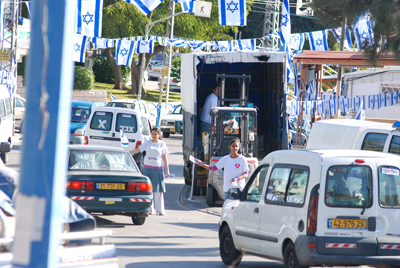Sderot, Israel (dpa) – This winter, Eli Asayag has opened the windows of his cafe.
A year ago they were tightly shuttered, hopeful protection against rockets that were raining down onto southern Israel and especially on Sderot, located about three kilometres from the Gaza Strip.
Sderot residents are breathing easier today, 12 months after last winter’s war between Israel and Gaza militants. Israel had launched the campaign after years of rocket fire from Gaza on its southern towns and villages.

“This last year was one of the calmest in the last 10, possibly even 20 years. Only 284 missiles were launched at southern Israel from the Gaza Strip, compared to 3,200 in 2008,” says Noam Bedein, who heads an NGO in Sderot.
“We feel the conflict has not ended 100 per cent, but we do feel a difference,” notes Sderot supermarket owner Yakov Dahan.
“At last our children can go out onto the streets, to join in outdoor activities,” he says.
Yet for all the palpable sense of relief residents say they feel after Israel’s offensive, the trauma of the past decade, when a total of 12,000 rockets were launched at southern Israel, remains.
Residents still remember the fear that the constant threat of rocket attacks used to bring.
Despite the anxiety, however, the effects of the relative calm are visible in the streets. Unlike last winter’s war, which turned Sderot into a ghost town as residents huddled fearfully indoors, people are venturing outdoors to go about their daily business.
There are fewer “for rent” of “for sale” signs hanging outside apartments. Real estate prices have in fact risen, as some who previously fled the town return home.
And locals are taking advantage of the lull to build safe rooms or bombshelters, turning Sderot from the one of the most shelled cities in the world in 2008, to one of the most bomb-sheltered city in the world now.
Built with government financial help, the new constructions look like normal rooms attached to a building, but they have walls which are 40 centimetres thick and reinforced with concrete.
Playgrounds too are still sheltered by reinforced concrete “umbrellas,” although these provide protection only against rockets with 3 kilogrammes of explosives or less. Latest rockets fired by the Gaza militias can carry between 20 to 40 kilogrammes of explosives.
And of course, the shelters only provide physical protection. Repairing the mental damage is another matter. Some 70 to 90 per cent of Sderot children suffer from some form of Post-Traumatic Stress Disorder, mental health experts estimate.
For Shula Sasson, the new calm in Sderot means that her family no longer sleep all together in the living room.
Her teenage son, traumatised after he was caught in the open during a missile barrage some years ago, also no longer insists on spending the night huddled in a claustrophobic steel shelter especially erected for him in a corner of the room.
However, the family keeps mattresses stacked behind the living room couch, in case they once again have to take shelter in the ground floor room at night. The makeshift protection built for their two mongrel dogs is also still on the back porch.
“It’s calm,” she notes of the relative lull, “but it’s a calm I cannot believe in.”
Every missile warning broadcast, she notes, triggers the same movie in her head.
She is not alone in this. And sometimes it does not even take a missile warning to trigger the old fear and the routine of running to find shelter in 15 seconds, residents say.
One woman walking outdoors soon after the Israeli offensive ended heard a boom of thunder and instinctively dropped to the ground to take whatever cover she could find.
Despite the careful, grateful optimism of residents that the lull has restored some semblance of normality to their lives, few believe that it will be permanent.
“Everything is very fragile,” Bedein notes. “Everyone understands it’s just a matter of time before fighting erupts again.”









